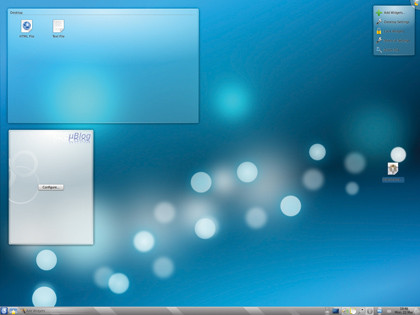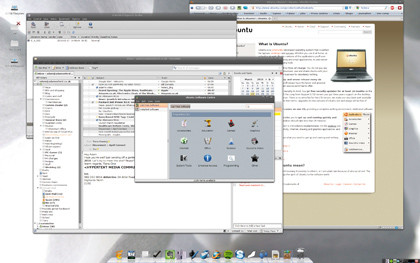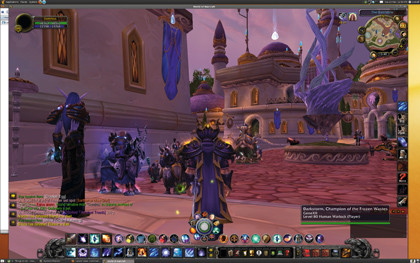Has Windows 7 killed Linux on the desktop?
Or will cloud computing give Linux another chance?
If you want to know what's coming up on Windows and OSX, try looking at Linux.
The features of the future are being tested there; either as part of the standard desktop environments, or as add-ons and replacement apps for parts of the interface.

PLASMIODS: KDE can be prettier than any other desktop, but the customisation options are terrifying
The current version of KDE, for example, uses a desktop model called 'Plasma' in which all the traditional desktop elements are reworked as lightweight widgets. You have a phenomenal amount of control over how these behave, which can be overwhelming at first, but it's very fast, and once you're used to it you can design your desktop around what you commonly do, rather than stay stuck in the traditional windows manager model.
It may be impracticable for a lot of people, but a few hours with KDE 4.4 is enough to make you realise that there might be a better way of working than the decades old desktop paradigm.
For example, every window can be nested and tabbed, so you can have several apps clustered together in groups, ready to be called up for a specific task. KDE 4.4 is also designed to be able to blur the distinction between local apps and web-based ones too, and native apps can pull in information from wherever is most relevant.
The most popular Linux desktop environment, Gnome, is about to be overhauled for a 3.0 release. Like KDE 4, it's a big rethink of the traditional desktop paradigm, geared around managing large numbers of workspaces, not just windows.
Get daily insight, inspiration and deals in your inbox
Sign up for breaking news, reviews, opinion, top tech deals, and more.
Mac OSX recently caught up with Linux' clever organisational tricks by enabling you to start up several desktops at once on one machine; so one work area could be web surfing and mail, for example, with a different one for photo editing.
Gnome 3.0 goes a step further by placing the start menu in a zoomed out meta-desktop made up of several smaller segments, and allows you to choose which space to start an app running in before focussing in to use it.
Like the KDE team, many Linux package maintainers are looking ahead to anticipate the next phase of cloud-based computing. There's Google's Chrome OS, for example, which is crafted largely around web apps.
The next version of Ubuntu, too, will have a 'MeMenu'. This puts a TweetDeck-like microblogging client into the taskbar and can update the world on exactly what it is you're doing at any particular time.
Ubuntu's One service is a neat take on Dropbox-style storage too, treating an online space as just another hard drive, but syncing with the default email and note client too.
Intel's Moblin, meanwhile, is a Linux distribution specially coded for netbooks which boots from cold in around 15 seconds. It's designed to launch simple applications, such as social networking, fast, but has an online 'garage' of free software for adding in the usual array of freely available word processors, image-editing programs and simple games, so it can quite quickly take the place of a 'proper' desktop.
Moblin's application launcher gets rid of the traditional windowed environment altogether, instead it starts each new app on its own desktop space, or zone. It may seem counter intuitive, but it prevents a tiny netbook screen from getting cluttered and, while it doesn't support multitouch yet, it could be a far better way of organising running apps in a large, finger-friendly manner.
NB: Intel and Nokia have merged Moblin and Maemo to form MeeGo

SEEM SIMILAR?: Linux distros have become far more familiar to the Windows user
Beyond the core functions of the desktop environment, though, the modular nature of Linux means that it's far easier to customise and replace key parts of the desktop from any distribution – using a dock in favour of the taskbar, for example – than it is in Windows, and there isn't the same performance penalty either.
There is a downside to the amount of innovation going on at the basic level in Linux development. Like Google's apps, a lot of software and features hang around in alpha or beta status for a long time and still get picked up by package maintainers. which can cause stability issues for the unwary and uninitiated.
On the other hand, Linux developers have made massive headway against the traditional weaknesses of the OS over the last year. It's WiFi cards, not GPUs and sound cards, which remain tricky to configure and find drivers for, and you can go without opening a terminal for months on end these days.
It's the economics, stupid
The biggest appeal of Linux will always be that it's free. Saving the best part of £100 on a self-built PC, which doesn't have to run Windows is always a worthwhile endeavour.
Linux really comes into its own if you're putting together a machine for a very specific purpose, such as a media server, because there's a very good chance someone has already packaged together a distro that will do everything you need for nowt.

WOW: The very fact you can play World of Warcraft on Linux is enough of a reason to try it
Take MythBuntu, for example. Assuming you want a low cost, low power box that will just sit by your TV recording live shows and playing back DVDs or downloaded content, why bother with Windows 7?
MythBuntu is simply a skinned variation of Ubuntu which can boot straight into MythTV, an open source PVR app. It's simple to set up, takes critical updates from the highly reliable Ubuntu repositories and works with a wide variety of TV cards and media hardware. There's a UPnP server built in for sharing any files you store on your MythBuntu PC too.
Or you could try LinuxMCE, another dedicated media centre distro, which has a ten foot interface for HDTVs and can handle the same broad spectrum of audio and video files.
There's even a distro for professional media generation. UbuntuStudio is a complete suite of stable audio visual editing tools, including Cinelerra and Blender which can produce broadcast quality results without the enormous licensing costs of proprietary software.
Ironically, though, there's a fairly poor selection of apps available for the most popular kinds of media editing. Most of the software it contains is way too complex for just chopping a few seconds off of a video you made with your phone.
There is one small problem. Playback is pretty much sorted, but Linux definitely lags behind Windows for media creation. Ironically, simple tasks like putting together a movie for YouTube or uploading a photo to Flickr can be harder to achieve than cutting together the next Lord of the Rings.
Only sleeping
While Vista didn't do much to improve Windows popularity, and Windows 7 will undoubtedly woo some folk away, it's only a short term thing at best. Google's Chrome OS is coming, which will help to considerably bolster the Linux cause, both in terms of increasing the number of PCs that ship with Linux and encouraging developers to create more interesting apps.
And no matter what your thoughts about the business ethics of Microsoft or the hippy nerd nature of Linux, as applications and eventually even games move off of the desktop and into the cloud the differences between all operating systems will become smaller and less meaningful.
So you might as well try Linux out now, while it still matters. Who knows, you might even like it.